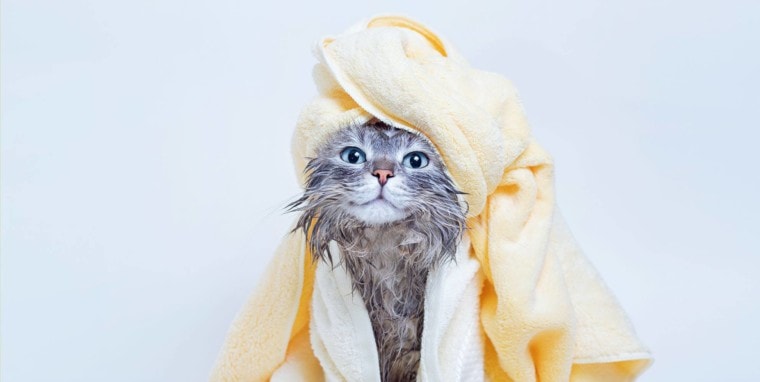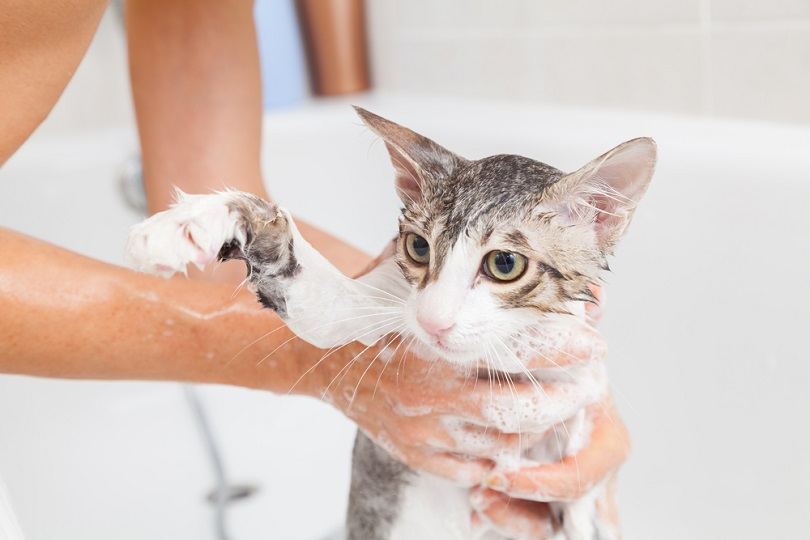
Most cats do a great job of keeping themselves clean. But every now and then, you might need to give your cat a bath. Your cat may accidentally roll in oil that’s dripped on your driveway or have a skin infection that needs medicated shampoo.
Giving your cat a bath is much easier if you have a helper. They can refill the water pitcher, offer your cat plenty of treats, and have a towel ready to wrap your cat in once the bath is finished.
What Do You Need For a Cat Bath

Before you give your cat a bath, make sure you have everything that you need on hand. This is our recommended list:
The 11 Steps to Giving Your Cat a Bath
1. Fill your tub with warm water
We find that using a small tub, baby bath, or even a sink is much easier than trying to bathe your cat in a full-size tub. You’ll only need to fill your small tub with up to 5 inches of water. Check the temperature so it’s comfortably warm but not too hot. You may want to wear thick rubber gloves if you think that your cat might scratch you.
2. Gently place your cat in the tub
Lower your cat into the tub, and let them get used to the sensation of the water on their paws. At this point, it’s a good idea to get your helper to offer your cat a few of their favorite treats. You can also get lickable treats and squeeze this out along the side of the tub or sink for your cat to lick off. For some cats, this will distract them enough that you’ll be able to bathe them without too much fuss.
3. Use the pitcher to get your cat’s coat wet
Dip the pitcher in the water (or fill from the sink if you have a helper), and wet your cat’s coat down thoroughly. Start at their shoulders, and work your way down to their tail. You may need to massage their coat with your fingers to make sure you penetrate all the way down to their skin. This step is particularly important if you’re using a medicated shampoo. At this point, leave your cat’s head dry.
4. Apply shampoo
Apply your chosen shampoo according to the manufacturer’s instructions. Make sure you get the lather all over your cat’s coat. Work the shampoo in with your fingers, and massage your cat’s skin at the same time. Don’t be tempted to use too much shampoo, as that will make it much harder to fully rinse all the shampoo out.
Many medicated shampoos need to be left on your cat’s coat for up to 5 minutes. This is a great moment to give your cat more treats and distract them while you wait for the shampoo to work its magic.
Giving your pet a bath can be a difficult task, but the first step is to choose a great shampoo. We love Hepper's Shampoo Products, both of which are natural, pet-safe options specially formulated to clean your pet's skin and coat without causing irritation. Both formulas are also free of things like dyes, soaps, sulfates, and phthalates. Your pet will enjoy the soothing aloe vera and oatmeal, and you'll love the clean, fresh scents!
 |
 |
|
|---|---|---|
| Hepper Colloidal Oatmeal Pet Shampoo | Hepper Waterless No Rinse Pet Shampoo | |
| Natural Ingredients |
Natural Ingredients:
|
Natural Ingredients:
|
| Made in USA |
Made in USA:
|
Made in USA:
|
| Safe for cats & dogs |
Safe for cats & dogs:
|
Safe for cats & dogs:
|
| Soothes dry skin |
Soothes dry skin:
|
Soothes dry skin:
|
| Waterless, no rinsing required |
Waterless, no rinsing required:
|
Waterless, no rinsing required:
|
At Pet Keen, we've admired Hepper for many years, and decided to take a controlling ownership interest so that we could benefit from the outstanding designs of this cool cat company!
5. Wash your cat’s face and head
At this point, you should clean and wash your cat’s face. Most cats hate having water on their faces, so use a face cloth rather than pour water from the pitcher. Dampen the face cloth using the water from the tub, and apply a small amount of shampoo if necessary.

6. Clean your cat’s ears
If your cat’s ears need cleaning, dip a cotton ball into the water in the tub, squeeze it out fully, and then gently clean inside your cat’s ears. Don’t squeeze water into their ears, as this will be uncomfortable for your cat. If your cat’s ears don’t look dirty, you can skip this step.
7. Rinse your cat’s fur thoroughly
Dip the pitcher into the water in the tub, and gently pour it over your cat’s coat. Use your fingers to check that all traces of lather have been rinsed away. You may need to refill the pitcher with clean and warm water, which is when a helper will be useful! Once the water is running off your cat’s coat without any traces of bubbles, they’re nearly done!
8. Rinse your cat’s face and head
Rather than use the pitcher to pour water over your cat’s face and head, dampen down the face cloth again and use this to remove any lather from your cat’s head.
9. Remove as much water as possible from your cat’s coat
Run your hands down your cat’s body to try and squeeze as much water out of their coat as possible.
10. Lift your cat out of the tub and dry them down
Have a dry towel ready, and lift your cat out of the bath and onto the towel. Rub their coat to help it dry. You may need to use a fresh and dry towel if the first one becomes wet. Some longhaired cats may need a little help from a hairdryer, if they’ll tolerate it. Most cats will want to sit somewhere quiet and groom themselves as they dry off, and a heated cat bed is perfect for this because it will help them stay warm as their coat dry.
11. Give your cat a treat!
After your cat’s bath, give them more treats or a portion of their favorite food. Helping them to associate bath time with something positive, like lickable treats and a tasty meal afterward, will form positive associations and help your cat tolerate their baths. If you managed to successfully bathe your cat without getting any scratches or bites, then you probably deserve a treat too!

What type of shampoo to use?
That partly depends on why you’re bathing your cat. There are a few different reasons that you might be bathing your cat, including:
For most instances, we like the Frisco Oatmeal Shampoo With Aloe and Almond. If your cat needs a medicated shampoo for a specific skin condition, then your vet will be best placed to advise you on what to use, especially since you may need a prescription.
Using Dry Shampoo
If your cat cannot be convinced to tolerate a bath, you can try a waterless or dry shampoo instead. We love the Burt’s Bees Waterless Shampoo for Cats. All you need to do is spray your cat’s coat until it’s damp and rub their coat with a towel, and that’s it! Dry or waterless shampoo can be used to freshen up your cat’s coat and spot-clean small stains, but it won’t deal with infections or flea infestations, which need medicated shampoos.
Cats rarely enjoy their baths, but they can be trained to tolerate them. Using our step-by-step guide and stocking up on plenty of treats is the best way to ensure that bath time is as pleasant an experience as possible for both you and your cat!
Related read:
- Cat Sprayed by a Skunk? Here’s What to Do!
- How to Wash a Cat without Shampoo? – 10 Effective Methods
- 10 Ways to Calm a Cat for a Bath
Featured Image Credit: KDdesignphoto, Shutterstock







